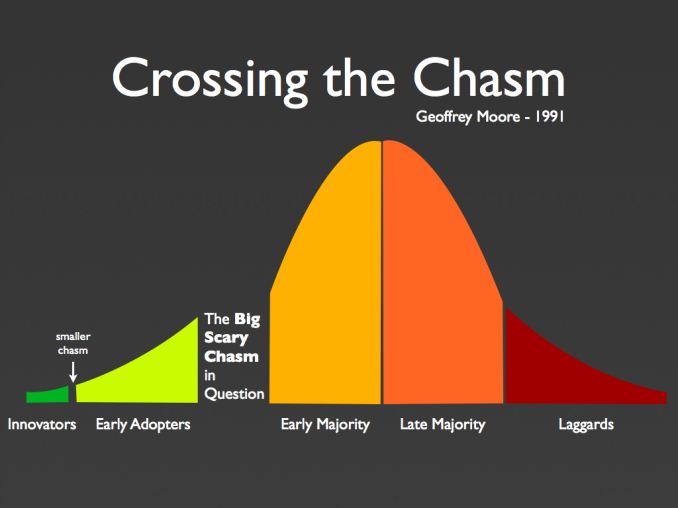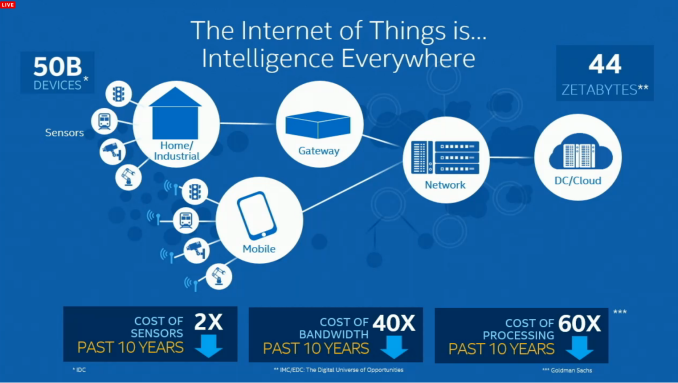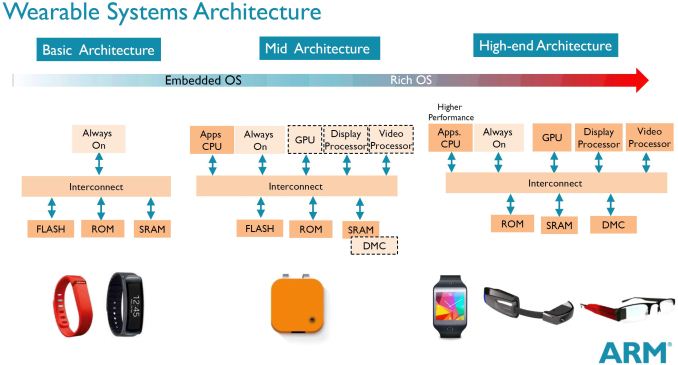Wearables: 2014 and Beyond
by Stephen Barrett on January 15, 2015 11:50 AM EST- Posted in
- Wearables
- Apple
- Microsoft
- pebble
- Android Wear
- Microsoft Band
- Fitbit

As the year 2014 has come to a close, now is a good time to inventory changes in the consumer electronics market and project those trends forward. One of the most obvious changes was that wearable technology has, by my observation, approached the brink of the adoption chasm into the early majority. In this article we will focus on the significant business and consumer factors of wearable technology, the notable introductions in 2014, as well as future AnandTech coverage.
If you are unfamiliar with ‘the chasm’, this is a reference to an acclaimed technology marketing book by Geoffrey A. Moore in 1991. As seen in the figure below, Geoffrey describes five stages of adoption.
The first, consumers described as innovators, are on the very bleeding edge. Innovators have a combination of unique interest in the subject area and abundant disposable income. There is a small chasm between this group and the next. This small chasm has killed many technologies and you could probably argue that 3D TVs died here. Next, early adopters are more like typical AnandTech readers. These consumers are technologically savvy and often the technology go-to person for groups of family and friends. Early adopters are likely to have made investments into products that their friends have yet to invest in themselves. My wife described me this way when I made the jump from iPhone to Windows Phone. It was an early product without majority adoption (and still is), but I wanted it anyway.
This brings us to The Big Scary Chasm in Question. How does a technology explode from a “hobby”, as famously Apple described its Apple TV, to a staple like the iPhone? In the information age of today, crossing this chasm is primarily a focus of marketing. Sure, you need good product, but without effective marketing there is little chance of wide adoption. There are plenty examples of products that have been favorably reviewed by AnandTech and others but didn't see widespread adoption. Often, it's a case of competing against the marketing budget of a much larger company, but that's a topic for another day. In short, going from a cult hit to a market leader is difficult; hence, the Chasm.
Taking this back to wearables, 2014 saw the most marketing of wearables yet, and for good reason. The traditionally explosive smartphone and tablet markets are slowing down. Analysts at CCS Insight projected a fall of smartphone sales' yearly growth from 40% in 2013 to 25% in 2014 and 15% in 2015. Analysts at Gartner project a fall of tablet sales' yearly growth from 55% in 2013 to 11% in 2014. IDC projects 2014 tablet growth even worse at 7%. At the same time, wearable revenue is projected to dramatically grow. ABI Research projects wearable technology at a compound annual growth rate (CAGR) of 56.1% over the next five years. Finally, Price Waterhouse Coopers’ interview samples show that 76% of consumers do not need a new wearable device to replace functionality of an existing device.
The top consumer eco system players – Apple, Microsoft, Google, and Google’s partners – are growth companies. Continually increasing revenue is a corporate foundation. Without revenue growth, careers stagnate as no promotions or raises are possible. Go long enough without growth and your top talent can leave for a company with growth opportunity. In Samsung’s recent 3rd Quarter financial results, their revenue fell 20% year over year and Samsung primarily attributed this to smartphone struggles.
With all this data combined, it is a no-brainer for these consumer companies to shift resources to wearables. Therefore, all have made significant wearable announcements. Google’s partners and Microsoft have launched devices while Apple is alone in the laggard position of having nothing on the market (with Apple Watch coming this year).
Wearables: What Are They?
At their core, wearables are of course technological devices that you wear. In some sense, your smartphone is actually a wearable. Even though a smartphone usually does not directly contact your body, it is a wearable just as much as a smart purse or backpack is a wearable. However, as smartphones are already a category of their own, they are traditionally excluded even though the core technology is vastly similar. That core technology consists of sensors, wireless, storage and computing. Intel’s recent IoT (Internet of Things) platform launch contained a slide detailing the cost reduction of some of these components, which is an enabling factor of wearable growth.
Where wearables differ from smartphones is their function. By breaking from the traditional smartphone form factor a wearable can provide different benefits. These benefits can be broken down into different categories that closely mirror the contents of the device as different sensors, processors, wireless, and storage enable different use cases.
On the left side of the above diagram from ARM are devices that contain wireless connectivity, sensors, a low power microcontroller such as Coretex-M, small amounts of memory and storage; run an embedded OS; and potentially have an optional display. The vast majority of these devices today are for fitness and health, however some provide smart watch functionality as well. On the middle and right side of the diagram are devices that integrate higher end processing and storage such as full-blown application processors (think Cortex-A series) and DDR memory. These allow running richer, non-embedded operating systems (such as Android) and higher-end features at the cost of power consumption.













79 Comments
View All Comments
wallysb01 - Thursday, January 15, 2015 - link
But what's the value added over a simple heart rate monitor, learning a thing or two, and doing it enough to just "know yourself"? People have been training based on fatigue or maximum exertion percentage for a long time now. As former triathlete and fitness nut, I just don't see how these things get going. A decent heart rate monitor is what, $20. Get a bike computer for another $20. You have the distance/speed already on any treadmill or stationary bike. So we're basically just talking runners, or bikers that MUST have a GPS.I just have a really hard time seeing very many fitness nuts spending $100-200 on this thing, and applications outside fitness seem very pointless as well. So you get notifications on your wrist? You don't have to take out your smart phone? How much money are people going to be willing to pay for THAT? Maybe it won't get the backlash of Google Glass, but I see it failing in a similar way, as a novelty 5% of your friends will show off to you, while you go "eh, you payed how much for that?", and 3 years later its mostly dead.
Impulses - Thursday, January 15, 2015 - link
Fitbit actually has devices covering a lot of price ranges... I wanted something to monitor my runs, not because I need it (I've been running for the past 15 yrs since high school without it), but it appeals to my geek sensibilities.I wasn't interested in all day tracking, I KNOW I'm a sedentary geek, don't need to be told... So I ended up buying the cheapest Fitbit Zip model which is a little $50 clip on thing, and I only wear it in on runs or when I go biking.
As far as I can tell it works as well as any pedometer, and it's easier to use and better connected than any other device at the price range. I continue using it even after getting a Wear watch because I'd rather not run with a leather strap, or any kind of visible watch for that matter.
Penti - Thursday, January 15, 2015 - link
I thought Fitbit discontinued or at least stopped developing all non-wrist stuff. But it appears they still sell their clip-based ones.Impulses - Friday, January 16, 2015 - link
Nope, the Zip keeps chugging along, Best Buy still has them in stock all the time, etc. It's pretty solid for $50, specially if you just want it to track specific workouts as I do rather than all day monitoring. It even syncs up with Android devices now, which wasn't possible originally.Impulses - Thursday, January 15, 2015 - link
$200 for a decent smart watch doesn't seem like a terrible value proposition to me, having enjoyed the convenience of one and knowing what I'd otherwise pay for a nice looking watch that I wouldn't use nearly as much.name99 - Thursday, January 15, 2015 - link
"b) people who can't be bothered taking their smart phone out of their pocket, which is all those watches enable - a short cut to see something your smart phone could show you."So your argument is, "people won't pay for convenience"? Yeah, good luck with that.
90% of what's sold in America, from McDonalds and Starbucks to dog walking and gardening services to microwave ovens and dishwashers are based not on "could *I* do this myself?" but on "I'd rather pay more for convenience!"...
wavetrex - Thursday, January 15, 2015 - link
Simple. Make a product that doesn't suck.Let's look at a Smartwatch of today:
- Shitty battery life
- Weak performance
- Difficult to see in sunshine
- Not really useful for anything
- Bloody expensive !
No wonder (almost) nobody buys them.
Suggestions:
- Use E-INK ffsake!A watch should be visible at anytime without having it to turn on. It will also be perfectly visible in the sunshine and not consume power.
- If you want colors, use OLED and a way to turn it on via motion (shaking?) so you can look at it without actually "touching" the device.
- A permanent "deep sleep" mode, when not use only the detection sensor should be on. CPU, RAM, everything should be completely off and not consuming power.
- Design a simple and efficient OS from scratch that can initialize in less than 2 seconds from some fast flash memory, basically fast-booting every time you look at it, other than that the device would be almost OFF and not consuming power. PC Os'es like Linux (on which Android is based are NOT GOOD for these kind of devices!)
- No fancy animations and stuff in the interface, just simplicity and efficiency. THIS IS NOT A PHONE OR COMPUTER! It's a WATCH.
- Camera ? Putting a camera on a wrist watch ? That's madness ! Useless feature of the century...
- In time it will become cheap if a lot of people like them, consider them useful and buy them.
I know almost nobody from the tech companies will read this comment but... whatever.
Schnydz - Thursday, January 15, 2015 - link
I can agree with most of this. It comes down to simplicity doesn't it? It seems the smaller the device the more simpler it should be. So, if we are talking about a watch then keep the UI/UX as simple as possible. Have tried using the Moto360 and man what a useless PoS. I have a feeling the apple watch with be more of the same. In my opinion MSFT is on to something with their fitness band. The design and "feel" just needs a couple of revisions...it's just a tad too bulky. But, keep it simple!nevertell - Thursday, January 15, 2015 - link
"Design a simple and efficient OS from scratch that can initialize in less than 2 seconds"Linux is able to do that, provided that you don't need to run a virtual machine to execute all of the applications and you don't load all of the modules you can get in a standard linux tarball off of the repo for armv7 kernels.
XabanakFanatik - Thursday, January 15, 2015 - link
My Microsoft Band takes 4 seconds from the moment you push the power button to being completely booted and usable for all features. I'm not sure why any other watch takes longer.